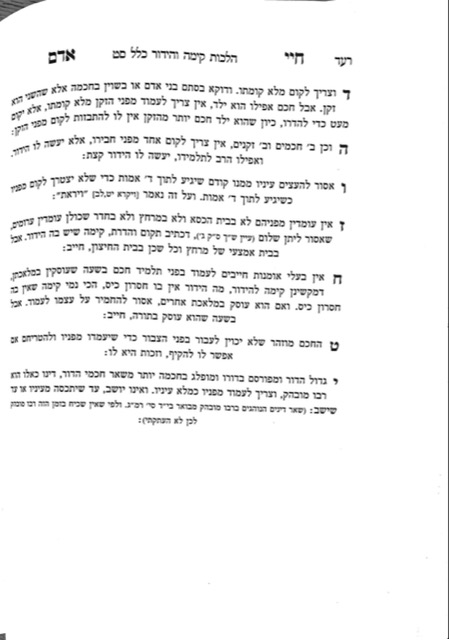We are beginning siman 10. The Chayei Adam points out that a rebbe muvhak is not so applicable nowadays, as we learned previously (shiur 1490). However, he writes that there is one exception, which is a gadol hador. A gadol hador is understood to be an individual who is clearly head and shoulders above the rest of the generation. Even if one has not learned from the gadol at all, the chiyuv kavod is the same as a rebbe muvhak.
While for a regular rebbe or talmid chacham , one must stand up when the rebbe is within four amos, and may sit down either immediately after they pass or after they have passed four amos (see shiur 1485), for a rebbe muvhak, the chiyuv to stand begins from the moment one sees the gadol, and remains until the gadol is out of eyesight or is in their place. This chiyuv is not dependent on four amos, and is similar to the chiyuv of standing for a Sefer Torah. As long as a Sefer Torah is on the move, one is chayav to stand up for it. One must remain standing until it is in its place, either in its place on the bimah or in the aron, or held by someone sitting.
Once the gadol or rebbe muvhak has reached their place, one is no longer chayav to stand, even if the gadol or rebbe muvhak is still standing. Thus, for example, when the gadol or rebbe muvhak stands for parts of davening, one is not chayav to stand along with them, because they are already in their place.
Rav Yaakov Kaminetsky once came to Telshe Yeshiva from the bris of a great-grandson. When he arrived, Rav Gifter was in the middle of a shmuess. Rav Yaakov wanted to enter quietly and enjoy the shmuess, but when he entered, Rav Gifter stopped, and the entire beis medrash stood up until he got to his place, in line with the halacha we have just learned.
The Chayei Adam points out that other halachos of rebbe muvhak can be found in Yoreh Deah, and that he will not discuss them because they are not so relevant anymore, as we have learned (shiur 1490).
The Chayei Adam has been primarily discussing the halachos of kimah, standing. We also learned that there is a concept of hiddur, and we have learned that hiddur is often directly connected to kimah, in that the chiyuv kimah generally only applies when there is hiddur (shiur 1485. 1489). We need to discuss if there are ever situations in which there is a chiyuv hiddur even though there is no chiyuv kimah, and whether there are any issurim related to bizayon of a talmid chacham which exist regardless of the chiyuv kimah.
Summary
- Although we have learned that for a talmid chacham, the chiyuv kimah begins within four amos and ends once the talmid chacham has passed, for a gadol hador or rebbe muvhak, it begins when the gadol or rebbe is in eyesight, and extends until they are out of eyesight or have reached their place.



